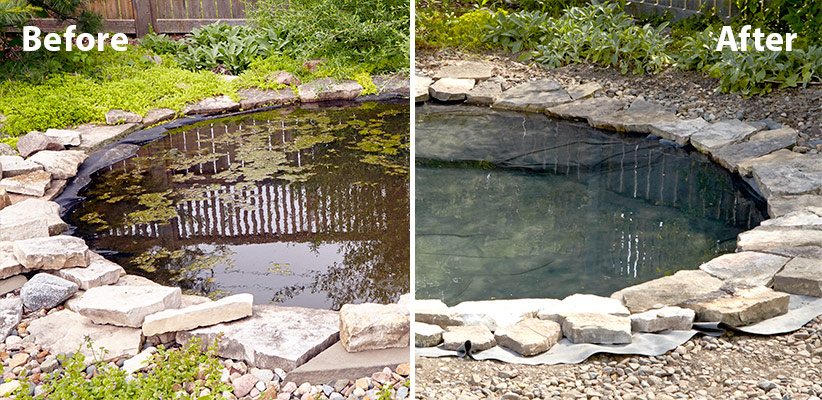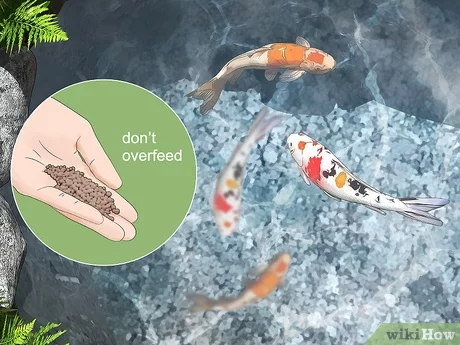Algae can quickly take over a pond, turning the water green and creating an unsightly mess. Not only does algae make your pond look unattractive, but it can also harm fish and other aquatic life. If you’re dealing with an algae problem in your pond, don’t worry! There are several effective ways to get algae out of a pond and restore its beauty and health.
1. Manual Removal
One of the simplest and most effective ways to get rid of algae in your pond is through manual removal. This involves physically removing the algae from the water using a net or rake. Make sure to wear gloves to protect your hands and arms from any sharp edges or toxins that may be present in the algae.
Using a net or rake, skim the surface of the water to remove floating algae. You can also manually remove algae that has attached itself to rocks, plants, or other surfaces in the pond. Regular manual removal can help keep algae levels under control and prevent them from taking over your pond.

Credit: www.youtube.com
2. Barley Straw
Barley straw is a natural and effective way to control algae in ponds. When barley straw breaks down in water, it releases compounds that inhibit the growth of algae. You can purchase barley straw bales or pellets specifically designed for pond use.
Simply place the barley straw in a mesh bag or container and submerge it in the pond. The barley straw will gradually decompose, releasing its algae-fighting compounds into the water. Barley straw is a safe and environmentally friendly way to control algae and improve water clarity in your pond.
3. Pond Aeration
Pond aeration is another effective method for getting rid of algae in a pond. Aeration helps increase oxygen levels in the water, which can inhibit the growth of algae. By installing a pond aerator, you can create a healthy environment for fish and other aquatic life while reducing algae blooms.
There are several types of pond aerators available, including surface aerators, diffused aerators, and fountain aerators. Choose the type of aerator that best suits the size and depth of your pond. Proper aeration can help prevent algae from taking over your pond and keep the water clear and healthy.
4. Beneficial Bacteria
Introducing beneficial bacteria into your pond can help control algae growth and improve water quality. Beneficial bacteria break down organic matter, such as fish waste and decaying plants, that contribute to algae blooms. These bacteria can also outcompete algae for nutrients, helping to keep algae levels in check.
You can find beneficial bacteria products specifically designed for ponds at garden centers or online retailers. Follow the manufacturer’s instructions for dosing your pond with beneficial bacteria to achieve the best results. Regularly adding beneficial bacteria to your pond can help maintain a healthy balance and reduce algae growth.

Credit: www.gardengatemagazine.com
5. UV Clarifiers
UV clarifiers are an effective tool for controlling algae in ponds. These devices use ultraviolet light to kill algae cells and prevent them from reproducing. UV clarifiers are easy to install and can help keep your pond water clear and free of algae.
When installing a UV clarifier, place it in an area where the water passes through it before returning to the pond. The ultraviolet light will target algae cells in the water, reducing algae blooms and improving water quality. UV clarifiers are a low-maintenance way to control algae and keep your pond looking its best.
6. Chemical Treatments
While chemical treatments should be used as a last resort, they can be effective in controlling severe algae problems in ponds. Algaecides are chemical compounds designed to kill algae and prevent its regrowth. When using algaecides, make sure to follow the manufacturer’s instructions carefully to avoid harming fish or other aquatic life.
It’s important to note that chemical treatments may have temporary effects and can disrupt the balance of your pond ecosystem. Use chemical treatments sparingly and consider other methods of algae control first. If you do choose to use algaecides, monitor water quality closely and make adjustments as needed.
7. Preventative Measures
Preventing algae growth in the first place is key to maintaining a healthy pond. Regular maintenance, such as removing debris, trimming plants, and monitoring nutrient levels, can help prevent algae blooms from occurring. Here are some preventative measures you can take to keep algae out of your pond:
- Limit the amount of direct sunlight reaching the pond.
- Keep the pond well-aerated to discourage algae growth.
- Avoid overfeeding fish, as excess food can contribute to algae blooms.
- Add shade-providing plants or structures around the pond.
- Regularly test and monitor water quality parameters.
Conclusion
Algae can be a nuisance in ponds, but with the right strategies, you can effectively get rid of algae and restore the health and beauty of your pond. Whether you choose manual removal, natural remedies like barley straw and beneficial bacteria, or technology like UV clarifiers, there are plenty of options available to help you combat algae growth.
By implementing preventative measures and regular maintenance practices, you can keep algae out of your pond and create a thriving aquatic ecosystem. Remember to monitor water quality, test nutrient levels, and address any issues promptly to ensure your pond remains clear and healthy for years to come.





